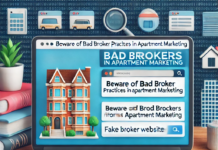My name is Jason Mazur and I am the cofounder of All Points Digital. My background is all digital marketing for eCommerce, B2B, and B2C organizations. However, A good portion of my career was in property management, where I worked with a variety of people in the industry, most of whom were in roles where their performance was judged by keeping occupancy up and exposure down. Since starting All Points Digital, I’ve continued to keep my finger on the pulse of the space, as our agency has leveraged that domain knowledge to offer digital marketing services to a number of property management companies.
I pride myself on being a “numbers guy”, and through my experience with the property management vertical, I’ve seen one common and frustrating mistake. The industry, in general, doesn’t bother doing the basic math that can save big dollars.
When I talk to the management team for an established property, I like to ask one leading question:
What’s the cost per lease for all of your marketing channels?
Almost without an exception, the response is either a blank stare or an unsubstantiated guess. This makes zero sense. Whether it’s a personal purchase or a business investment, when you spend money you should know what you get, when you get it, and what it costs. Evaluating marketing dollars used to acquire leases should be no different.
Today, the property management world steers their marketing activities based on emotion. Marketing budgets are shifted and island decisions are made in reaction to a gut feeling that “traffic is slow”, hoping broadly that “if we bump up our activities we’ll get more people in the door”.
The industry needs to step back and take a more analytical approach. Get command of critical metrics such as exposure, lead to lease times, conversion rates, and channel-specific cost-per-lead. Understand the various levers that can be pulled to generate predictable results.
Businesses that transact heavily online, like e-commerce B2C companies, have had to learn these lessons to stay competitive and profitable. Show me an e-commerce manager that can’t tell you the target ROI of their Google Ads campaigns, and I’ll show you an e-commerce manager that’s not long for their job.
The apartment industry has lagged behind, perhaps because the actual conversion often happens later, offline, as the result of a tour. What we need to realize is that the difference is almost entirely superficial. Signing a lease and completing an online checkout are each just a revenue-generating event that represents a conversion activity during the customer journey.
So how can we improve? It starts by asking the right questions. The following will yield an understanding of marketing costs across various channels and allow teams to truly evaluate marketing spend. As a result, teams can make better investment decisions with their marketing dollars.
What is the target Cost Per Lease?
The Cost Per Lease (CPL) is the single most important metric – the key performance indicator (KPI) that can be used to compare the effectiveness of different marketing channels, tactics, and campaigns. Simply put, CPL is defined as the average cost of generating a new lease through a given marketing channel.
The target Cost Per Lease should be defined based on the dollars that the company can afford to spend to generate a lease while covering other costs and meeting profitability goals. If it costs $25 to produce a widget, and you’re selling it online for $70, and you want to make at least $10 on the deal, you should be willing to spend $35 as your “cost per acquisition” (CPA). The same math can be applied to a lease. What’s the typical lifetime value of that lease (understanding that the initial term may be renewed?). What are the hard costs associated with that unit, and what other associated costs should be covered? Is there a minimum additional profit requirement?
Once you’ve figured this out (and it might be different between unit types), you have the basis for evaluating, in absolute terms, where a given marketing tactic is “worth it”.
What are the true CPL opportunities?
So, once you have a target CPL in mind, you can begin not only to discount ineffective tactics but to compare the various marketing channels at your disposal. Typically, there are only a handful of sources that ultimately generate leases, so this is fairly straightforward to learn and understand.
Drive By Traffic
Generally, there is a small set of traffic and/or leads generated from the apartment building itself. Although you can’t go out and change your location, you can make this source stand out by adding signage, balloons etc. Typically, drive-by traffic can yield the most inexpensive CPL. However, this is the least scalable lease source because you can’t ramp up drive by traffic when occupancy is low. Simply put, you can only generate as much traffic as the amount that physically drives by the building.
Resident Referral
Resident referral programs are extremely under utilized within the industry. Actively promoting a large, incentive-based referral program can cut costs and reduce vacancy. Resident referrals also offer a low-risk marketing channel because they are 100% incentive based. Plus, referral programs come with a built-in recommendation because they come from the applicants peers. The downside to such programs is that they can lack predictability and may, in some cases, be tough to administer.
Search Engine Marketing
Search Engine Marketing (SEM) references those sponsored results that you see in search engines like Google and Bing, as well as the graphic “display” ads that you see on web properties throughout the internet.
Search Engine Marketing is one of the easiest “dials” to control in your marketing arsenal. Ads can be targeted by keywords and geography, and you can typically generate as many clicks as you are willing to pay for. It’s also very easy to track, as the advertising platforms provide tools and reports to understand how many phone calls, form fills, and other actions people are taking based on those ads, as well as what was paid to generate those results.
Oddly, this is where we see the substantial disconnect with how the industry markets for apartments. Paid search engine marketing is often one of the most cost-effective and immediate ways to generate activity for a given property, yet it remains underutilized and misunderstood.
So my question to the apartment industry is “why aren’t you?”. It is easy to track every phone call, form fill, and even walk-in traffic to extremely specific sources.
Frequently, we look under the hood at lead sources reported by property management platforms and see “website” listed as a source. That’s almost as silly as saying that a “tour” was the source of a lease. Frankly, the source “website” is the most ridiculous piece of information in most property management software solution’s “lead to lease reports”. If tracking is implemented correctly, you should know your exact “Cost Per Lead” and “Cost Per Lease” for each and every digital campaign that is active. If someone clicks on your ad that mentions “doggies are more than welcome” that was triggered by a Google Search for “pet friendly apartments in Phoenix” and places the call on your website on the amenities page; you should know that information!
Internet Listing Services
Internet Listing Services (ILSs) are, in my opinion, one of the most overpriced marketing channels in the apartment industry. ILSs reel you in with the affordable base package, then all of a sudden you are paying over $1,000/month for their “diamond package”. In most case studies we have done, we have found that ILS underperform the vast majority of other advertising channels, as manifested by the highest cost per lease out of all evaluated tactics.
So why do property managers feel compelled to sign up for an ILS? I think there’s one primary reason – they are acting on emotion and feel they HAVE to be on the major ILSs to be competitive.
Fortunately, based on our work and well-measured results, we know that this is absolutely not the case.
Think about it logically. In today’s world, where do people go to search for something? They use a search engine. That’s where the eyeballs are. They are mostly on Google, and there are only a handful of others that matter at all. Domain-specific directories, which is really what an ILS represents, are fast becoming dinosaurs.
Do you really want to pay an ILS for a lead that’s generated by someone’s Google Search that leads them to click on that ILS listing of the property rather than your own? In some ways, the money you spend with an ILS is paying them to compete against you on Google and other search platforms!
While nothing is absolute, it rarely makes any sense to prioritize dollars for an ILSs over your own Google Ads campaign. If you are paying for an ILS and you are not running a paid search campaign, you are mismanaging your marketing spend – plain and simple.
However, there are scenarios where ILSs make perfect sense as a supplement to other tactics. Using ILSs in addition to your own digital presence can further scale your reach and online presence, which can be a useful tool in particular geographies or for certain property profiles.
Once again, it boils down to measuring your results. Make sure you know the cost per lead for each ILS, how that relates to the cost per lead, and how those numbers compare to what you observe on other channels.
Email Marketing
Email marketing is another severely underutilized platform for apartments. In my experience, it’s rare to find a property that employs a mature email marketing strategy. Instead, property managers think of “email marketing” for a couple of scenarios:
Sending an email out to residents to try to recoup money (rent due etc.)
Producing a community newsletter from the property that 99% of the residents care absolutely nothing about.
It should come as no surprise that there is a bit more to email marketing than collections and obligatory communications! Despite claims of its demise and widespread disdain for spam, studies have shown that email marketing is one of the most effective marketing channels for online businesses. Email has been shown to have particular efficacy when used as a reinforcement and reminder to those considering an expensive or otherwise consequential purchase… such as renting an apartment where they will be living.
So why don’t people consider email marketing as an effective channel within the property management world? Once a prospective resident tours the property, the communication should not end when they walk out the door. Use email to nurture and remarket to those individuals. Email can also be effective to cultivate ambassadors by promoting resident referral programs.
There are many possibilities with email, and a little creativity can go a long way. But just like everything else – don’t just do things because you think they are working. Track email campaigns like anything else, and ensure that you can track down resulting leases to calculate a real cost-per-lease.
Just because an email isn’t an online ad or a radio spot does not mean that it’s without cost. Don’t forget to calculate expenses related to the time it takes to build and run these campaigns, whether that’s a portion of an employee’s salary or outside agency fees!
Search Engine Optimization
Search Engine Optimization (SEO) presents another marketing channel that offers an extremely cost effective CPL. Search Engine Optimization is a set of related activities that are used to drive “organic” search traffic to your website. As opposed to search engine marketing, where you are explicitly paying for clicks (and indirectly, for visibility in search results), SEO is the practice of earning your spot in the search engine results pages (SERPs).
With paid online advertising, once a dollar is spent on a click, that dollar has little if any residual value. With investments in SEO, the goal is to build a foundation of online relevancy that will slowly improve online visibility in search engines over time. This means that every dollar invested into SEO drives evergreen results.
When you invest in SEO, you are playing the long game. A dollar spent today is unlikely to drive any return for at least three months, and may not truly bear fruit until a year or more down the road. This doesn’t work well in an industry that is accustomed to tight budgets and reactive decision making. Most property management companies either elect to ignore SEO entirely, or budget a trivial amount that is wholly insufficient to drive results in an effort to “check that box”.
Companies with the ability to afford to wait a bit for the result to mature can use a hefty investment in SEO activities to capture that same Google Ads traffic you would otherwise buy for a fraction of the cost.
Would it be nice to show up in Google’s Map pack for “Best apartments in downtown Dallas”? That person who searched that key phrase is a hand raiser and is a high-intent prospect.
While the tactics involved in SEO are varied and beyond the scope of this article, it’s important to note that it’s a lot more than stuffing a bunch of keywords on the website. There are thousands of hacks peddling dime-a-dozen SEO “services” that yield nothing. Successful SEO is a complex field that requires a combination of on-site content and structural optimizations, quality procurement of inbound links via smart content marketing, citation management, and reputation management.
For instance, did you know that, Google Reviews have a direct impact on your local rankings? If you don’t have a decent number of 4-star reviews, Google will omit you entirely from certain search results. As such, a review solicitation and reputation management process is an absolute MUST!
Events, and Other Conventional Direct Marketing Channels
There are a ton of other ways to market properties, including some of those “old fashioned” activities that don’t involve someone sitting behind a screen and clicking. If you can utilize one of these other channels to get an effective cost per lease, more power to you!
In Summary
In summary, the best way to advertise your property is to utilize a cohesive strategy that uses multiple channels in concert (an omni-channel approach). Each of these channels should be effectively instrumented so that you know not only how much money is going into each, but how much is coming out the other side in the form of new leases.
As you evaluate these channels, they can now be compared the same way: “What is the cost per qualified lead?” and “What is the cost per lease?. The answers to these questions will allow you to optimize the allocation of your advertising dollars with more predictable results. As a result, you’ll be able to expertly pull the right levers to dial in the most effective marketing mix for your property. You’ll sleep a lot better knowing that all of your units will be chock-full of residents tucked comfortably in their revenue-generating beds.





